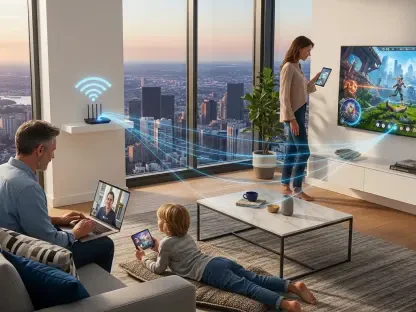In an era where digital connectivity underpins nearly every aspect of business, the expectation for seamless network access indoors has become a non-negotiable standard for enterprises across diverse sectors, from corporate offices to sprawling hospitals. Whether stepping into a bustling hotel or a university campus, individuals anticipate uninterrupted mobile service for everything from video conferencing to real-time data applications. Yet, the harsh reality is that many indoor spaces still grapple with dropped signals and patchy coverage, leading to widespread frustration among users and significant disruptions to critical workflows. This persistent gap in connectivity is not merely an inconvenience but a pressing challenge that enterprises must address to remain competitive. As reliance on constant communication grows, poor indoor networks can undermine employee productivity, erode customer satisfaction, and even jeopardize safety in high-stakes environments like healthcare facilities. The solution lies in recognizing indoor cellular systems as an indispensable component of modern infrastructure, bridging the divide between expectation and reality with robust, purpose-built technology.
The Limitations of Wi-Fi Alone
Why Wi-Fi Isn’t Enough for Modern Demands
Wi-Fi has been a trusted backbone of enterprise connectivity for years, valued for its adaptability and affordability in handling routine tasks such as email communication, media streaming, and connecting IoT devices. However, as building designs become more intricate and the digital landscape evolves with an influx of devices and data-intensive applications, Wi-Fi frequently falls short of delivering consistent performance. Coverage gaps emerge in areas distant from access points, while signal strength diminishes through dense walls or in crowded spaces, resulting in frustrating dead zones. These shortcomings can halt critical business operations, from delayed communications to interrupted access to cloud-based tools, ultimately impacting efficiency and user experience. The strain on Wi-Fi networks is a clear signal that enterprises need more than a single solution to meet the escalating demands of a hyperconnected workforce and clientele, pushing the need for alternative technologies to the forefront.
The limitations of Wi-Fi are particularly evident in environments with high user density or complex structural layouts, where maintaining uniform coverage becomes a daunting task. Bandwidth-heavy applications, such as high-definition video calls or real-time data analytics, often overwhelm Wi-Fi systems, leading to lagging connections and dropped sessions that disrupt productivity. Beyond operational hiccups, inconsistent Wi-Fi performance can erode trust among employees and customers who expect reliable access as a basic standard. In sectors where every second counts, such as financial trading floors or emergency response units, these connectivity failures can have severe repercussions, amplifying the urgency for a more robust approach. Enterprises must acknowledge that while Wi-Fi remains a vital tool, its inherent constraints necessitate a complementary system capable of ensuring seamless access across all corners of a facility, regardless of architectural or usage challenges.
The Need for a Complementary Solution
Relying solely on Wi-Fi exposes enterprises to persistent connectivity gaps that can no longer be ignored in today’s fast-paced digital environment. In large office complexes, warehouses, or multi-story buildings, Wi-Fi signals often weaken in remote areas or behind obstructive materials like concrete and steel, creating zones where mobile devices simply cannot connect. This inconsistency not only frustrates users but also hampers critical functions, such as real-time collaboration or access to essential systems during peak operational hours. Indoor cellular solutions, particularly those leveraging small cell architectures, emerge as a powerful remedy by delivering carrier-grade performance precisely where Wi-Fi struggles. These systems are engineered to penetrate structural barriers and support high-capacity usage, ensuring that connectivity remains stable even in the most challenging indoor settings, thus preserving workflow continuity.
Integrating indoor cellular with existing Wi-Fi networks creates a dual-connectivity framework that addresses the shortcomings of each technology while maximizing their strengths. Unlike Wi-Fi, which excels in routine data tasks but falters under heavy load or in expansive areas, indoor cellular provides dedicated mobile coverage that mirrors outdoor network reliability, catering to voice calls and carrier-specific services with precision. This synergy is especially crucial in environments hosting diverse user groups, such as shopping centers or corporate campuses, where varying network demands must be met simultaneously. By deploying purpose-built cellular systems alongside Wi-Fi, enterprises can eliminate dead zones and ensure a seamless transition for users moving between different areas of a building. This complementary approach not only enhances user satisfaction but also fortifies the infrastructure against the growing complexity of digital needs, setting a new benchmark for enterprise connectivity.
The Power of Indoor Cellular and Neutral Host Networks
Enhancing Coverage with Purpose-Built Systems
Purpose-built indoor cellular systems are revolutionizing how enterprises tackle the unique connectivity challenges of indoor environments, delivering unmatched coverage and capacity even in the most demanding scenarios. These solutions are specifically designed to overcome obstacles like thick walls, high user density, and signal interference, which often plague traditional networks in buildings. Advanced technologies, such as compact small cell architectures, provide high-performance 5G coverage with minimal footprint and energy efficiency, ensuring robust connectivity without disrupting a facility’s aesthetics or operations. Such systems are not mere add-ons but scalable infrastructure that can grow alongside an enterprise’s needs, adapting to increased device usage or technological advancements over time. By embedding these solutions into building designs, organizations ensure that mobile access remains consistent and reliable, supporting everything from daily tasks to critical communications with unwavering precision.
The impact of purpose-built indoor cellular systems extends beyond technical performance, fundamentally transforming how enterprises approach connectivity as a core component of their infrastructure. In settings like hospitals or universities, where large numbers of users rely on mobile networks simultaneously, these systems maintain service quality by distributing network load effectively across multiple access points. This capability prevents bottlenecks during peak usage periods, ensuring that applications like telemedicine consultations or online learning platforms operate without interruption. Furthermore, the integration of 5G-ready technology prepares facilities for future innovations, such as augmented reality tools or smart building systems, which demand ultra-low latency and high bandwidth. Enterprises investing in these solutions not only address current connectivity pain points but also position themselves as leaders in operational resilience, ready to embrace the next wave of digital transformation with confidence.
The Strategic Value of Neutral Host Models
Neutral host networks represent a groundbreaking shift in indoor cellular deployment, offering a cost-effective and future-proof solution by enabling multiple mobile network operators to share a single infrastructure. This model allows carriers such as Verizon, AT&T, and T-Mobile to coexist on the same system, eliminating the need for each to install separate equipment within a building. The result is a significant reduction in deployment and maintenance costs, making high-quality indoor coverage accessible to a wider range of facilities, from corporate high-rises to public venues. Beyond financial benefits, neutral host networks simplify the logistical complexities of managing multi-carrier environments, ensuring that users on different networks experience seamless connectivity without compatibility issues. This shared approach is a strategic win for enterprises aiming to meet diverse user needs while maintaining operational efficiency.
The long-term advantages of neutral host models are particularly evident in their ability to support emerging technologies like 5G, positioning buildings as adaptable hubs for digital innovation. By consolidating infrastructure, these networks reduce clutter and energy consumption, aligning with sustainability goals that many modern enterprises prioritize. Additionally, the centralized management of neutral host systems streamlines upgrades and troubleshooting, minimizing downtime and ensuring that connectivity remains robust as user demands evolve. This scalability is crucial for environments anticipating growth, such as expanding office campuses or retail complexes, where accommodating new carriers or technologies must be seamless. Adopting neutral host networks enables enterprises to future-proof their connectivity strategies, ensuring they remain agile and competitive in a landscape where digital performance increasingly defines success, while also fostering collaboration among industry stakeholders.
Meeting Evolving Enterprise and User Needs
Aligning with Operational and Safety Imperatives
Indoor cellular systems are far more than a convenience—they are deeply tied to the operational integrity and safety protocols of modern enterprises, especially in high-stakes sectors like healthcare. Reliable indoor coverage ensures that critical communications, such as emergency alerts or staff coordination during crises, function without fail, directly impacting response times and outcomes. In hospitals, for instance, doctors and nurses depend on mobile networks to access patient data or communicate urgently across sprawling facilities, where even a brief signal loss can have dire consequences. Beyond daily operations, robust indoor signals are essential for E911 services, providing accurate location data for emergency calls within large or complex structures. This safety dimension transforms connectivity into a non-negotiable priority, compelling enterprises to integrate cellular solutions as a fundamental safeguard for both personnel and visitors.
The operational benefits of indoor cellular extend to industries beyond healthcare, where seamless connectivity underpins efficiency and compliance with regulatory standards. In manufacturing plants or logistics hubs, for example, real-time communication via mobile devices enables swift decision-making and coordination across vast indoor spaces, preventing costly delays or errors. Moreover, in environments like schools or government buildings, where safety protocols demand instant communication during emergencies, dependable indoor coverage ensures that alerts reach all relevant parties without hindrance. The integration of cellular systems addresses these imperatives by delivering consistent network performance, even in areas prone to signal disruption due to structural barriers. Enterprises that prioritize such solutions not only enhance their operational resilience but also demonstrate a commitment to protecting lives and assets, reinforcing trust among stakeholders in an era where safety and reliability are paramount.
Catering to Workforce Mobility and Tenant Expectations
Modern workforces are increasingly mobile, with employees expecting uninterrupted network access as they move across buildings or campuses, often relying on personal devices under Bring Your Own Device (BYOD) policies. This shift demands a connectivity framework that supports multi-carrier access, ensuring that individuals on different networks can stay connected without encountering dead zones or dropped calls. Indoor cellular systems meet this need by providing comprehensive coverage that mirrors outdoor reliability, enabling seamless transitions between spaces during collaborative projects or client meetings. Such consistency is vital for maintaining productivity, as even minor disruptions can derail workflows or hinder communication in fast-paced corporate settings. By addressing mobility challenges, enterprises empower their teams to work flexibly and efficiently, aligning infrastructure with the dynamic nature of today’s professional landscape.
Tenant expectations in commercial real estate further amplify the importance of robust indoor connectivity, often positioning it as a decisive factor in leasing decisions. Property managers and building owners face growing pressure to offer high-quality network access as a standard amenity, akin to utilities like electricity or water, as businesses prioritize environments that support their digital operations. Indoor cellular solutions, especially those leveraging neutral host models, cater to this demand by ensuring multi-carrier compatibility and eliminating coverage gaps, thus enhancing a property’s appeal to prospective tenants. This trend is particularly pronounced in urban markets, where connectivity can differentiate a building in a competitive landscape, directly influencing occupancy rates and revenue. Enterprises and landlords alike benefit from investing in these systems, as they not only meet current user expectations but also position facilities as forward-thinking spaces ready for future technological demands.









